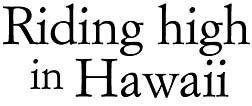Advertisement - Click to support our sponsors.



By Rob Perez
Star-Bulletin
AFTER a 13-year hiatus, Waipio-Gentry resident Gary Gavine figured it was time to have fun again.On two wheels.
So Gavine, 49, bought a Triumph motorcycle two years ago and has been having a blast -- 36,000 miles worth and counting -- ever since.
"I just realized as I commuted to work every day how much I really missed riding," said Gavine, who now uses his 900cc bike for his daily journey into town -- rain or shine.
"I feel happier driving a motorcycle than I do a car."
Gavine, who has been riding since he was 14, stopped in the mid-1980s when bike insurance locally became more costly than auto insurance, a situation that, except under certain circumstances, no longer is true.
The return of ex-riders such as Gavine is helping fuel a rise in two-wheeling popularity in Hawaii, according to industry sales people and safety instructors. Baby boomers in particular are discovering, or rediscovering, the joys of riding.
And as gas prices hover near $2 a gallon, some enthusiasts say ridership is bound to accelerate.

But given Hawaii's almost ideal riding weather and relatively short driving distances, some wonder why motorcycles aren't even more popular.Only 1.4 bikes per 100 people are registered in Hawaii, slightly below the national average of 1.5, according to industry data.
And the number of registrations statewide has remained relatively flat at around 17,000 the past five years.
Several reasons typically are cited to explain why registrations aren't on the rise or why motorcycling isn't more popular here.
The most common explanation has to do with what is considered the moderate or conforming bent of many island families.
"A lot of Oriental parents are conservative and don't want their kids riding motorcycles," said Bill Kato, sales manager at South Seas Cycles, the state's largest motorcycle dealership.
Morgan Keene, coordinator of motorcycle safety courses in the University of Hawaii community college system, sounds a similar theme.
"We have a very conservative population," she says. "And motorcycling is often times viewed as rather aberrant behavior that our conservative population is reluctant to buy into."
Robert Becker, operations manger for Cycle Sports and president-elect of the Hawaii Motorcycle Dealers Association, believes the lure of autos is a major factor as well.
"Hawaii is very much a car-driven economy," Becker says. "It's almost an obsession here."
Nationally, sales of new motorcycles have risen for eight straight years, according to the Motorcycle Industry Council, a trade group.
Bill Kresnak, a spokesman for the American Motorcycle Association, says the booming economy of the 1990s gave people extra spending money, some of which went toward bike purchases.
"When you have that discretionary income, you have extra money you can put into a hobby," Kresnak says. "Motorcycles fit that bill."
Although individual bike shops on Oahu say sales have been rising steadily the past several years, registration numbers don't reflect that trend.
Motorcycle registrations on Oahu have dropped 6 percent since 1995, to 11,747 last year, the most recent data available, according to county figures.
Keene says the declining numbers don't necessarily contradict the notion that motorcycling is becoming more popular. They simply underscore that a lot of people are riding unregistered bikes on Oahu, she says.
Keene estimates that roughly 30 percent of street bikes are not registered and thus are being operated illegally.
While most owners purchase bikes for secondary transportation, using them mostly for pleasure riding, occasional commutes or for running errands, owning a two-wheeler comes with distinct economic advantages.
Motorcycles usually get at least 30 miles per gallon and, depending on the bike and riding style, may cover as much as 50 to the gallon.
Also, insurance for many bikes can be substantially less than auto insurance, although young riders on sport bikes -- those so-called crotch rockets designed for extreme speeds -- can pay much more than what it would take to insure a typical car. Insurance premiums of several thousand dollars annually are not uncommon for relatively high-risk riders on sport bikes. One sales executive recalled an extreme case of a 17-year-old with a poor driving record who had an insurance tab of $7,000.
Like the price tag for a new car, the cost of a new motorcycle can vary greatly. A street bike can retail for as little as a few thousand dollars to nearly $30,000 for top-of-the-line custom machines.
In 1998, the most recent year for which statistics were available, riders spent an estimated $3.5 billion nationwide on new motorcycles, according to the motorcycle council. It did not have comparable numbers for Hawaii.
Despite the economic benefits of owning a bike, or the sheer pleasure that people like Gavine get from riding, motorcycling comes with some disadvantages.
Chief among them is safety. Compared with car occupants, riders are much more susceptible to serious injury or death if an accident happens.
For that reason, many riding enthusiasts suggest that new riders or those who have spent considerable time away from motorcycling take the state's safety class.
This year Keene and her instructors have taught about 2,000 riders, more than double the amount of a few years ago and the highest total since the courses started in the late 1970s.
Completing the $150 class comes with some extra benefits: graduates don't have to take a riding exam -- only a written one -- to get their licenses, plus they get 15 percent discounts for bike insurance.
Riding safe
What: Motorcycle Safety Foundation class for beginning riders
Where: Leeward Community College and Sand Island on Oahu
When: Usually on weekends
Course: Three days of riding, class instruction
Cost: $150
Benefits: Insurance discount, riding exam for license waived, learn good basic riding skills
Contact: 455-0307; (800) 303-1611 from Big Island, Maui and Kauai